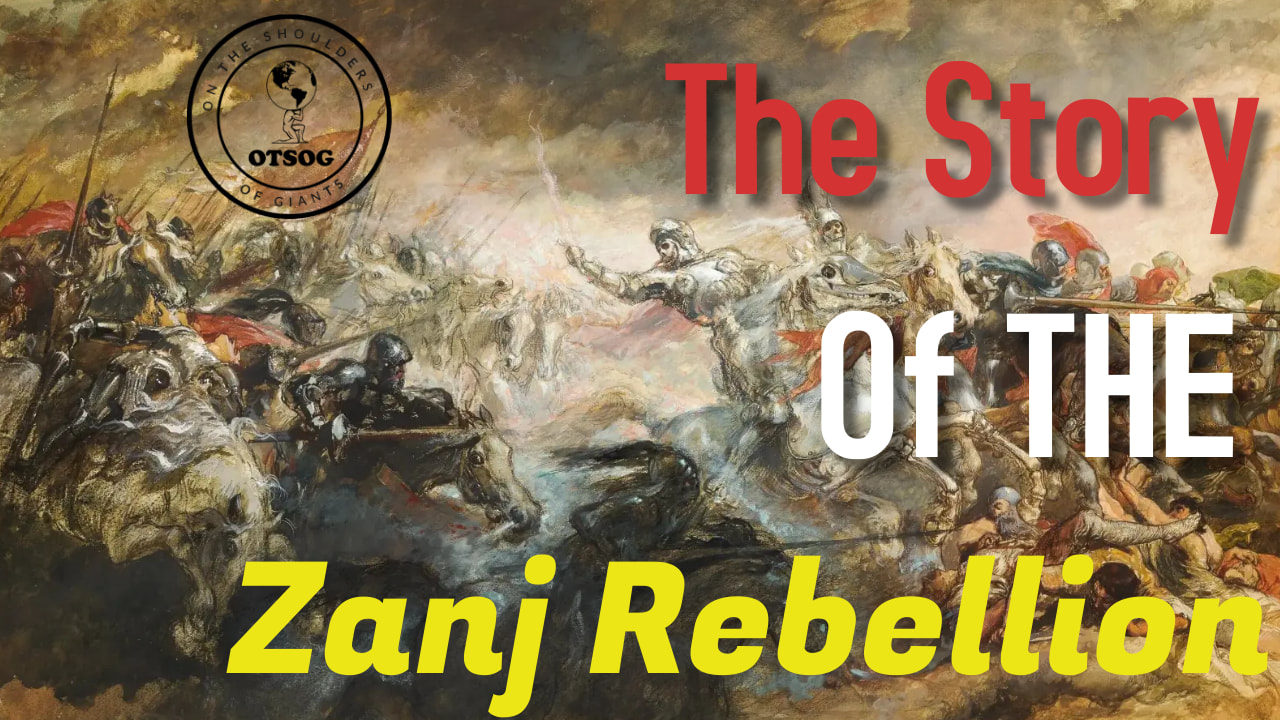|
The marshlands of Southern Iraq are the setting for today’s story. The Abbasid Caliphate were rulers of the Islamic world who came to power in 750 CE, after defeating the Umayyad Caliphate. At the time the city of Kufa, Iraq, was the capital city of the Caliphate, but their empire stretched from Libya to Iran. The marshlands were abandoned by their original inhabitants because the land became inhabitable due to excessive flooding which caused layers of natron to form on the land. Wealthy merchants and maganents were interested in buying the land to have it restored for agricultural purposes, and they would use servant labor to restore the lands. As the merchants and maganents proceeded with their plans, they either purchased or stole people from the east coast of Africa and the islands along the east coast of Africa. Over time the slave labor of the Abbasid consisted of people they conquered, but the Zanj specifically were classified as people from the East coast of Africa. The Abbasid slaves were deployed to the marshlands to work the lands until it became fit for agricultural production. Even though slavery in the Islamic world was different from chattel slavery, the conditions the Zanj lived and worked in were inhumane. As time passed and the working conditions did not improve for the Zanj, disdain for the Abbasid began to grow throughout the people. A number of the Zanj converted to Islam with the belief that their conditions would improve, but they were misled. Dissension was flowing through the Abbasid Caliphate beginning in 861 CE, the Anarchy of Samarra is what this period of dissension was called. During the Anarchy of Samarra, the Abbasid government was at odds with its military. This distraction allowed enslaved Zanj rebels to overtake certain provinces and maintain control because of a lack of government resources to oppose the rebels. Around 861 CE, Ali ibn Muhammad enters the picture and would become a central figure of the Zanj rebellion. Little is known about Muhammad’s background, he is said the be a descendent of a slave woman, but Muhammad himself claimed to be a descendent of Ali ibn Abi Talib, the cousin, and son-in-law of the Prophet Muhammad. But there is not enough information to verify either claim. Muhammad moved to the city of Bahrain in 863 CE. Because of his claims to be a descendent of Ali ibn Abi Talib, he amassed a large following where taxes were collected in his name and he was viewed as their ruler. He was even able to lead his followers into a rebellion against the Abbasid, which was quickly squashed. This defeat and humiliation lead Muhammad to relocate to the city of Basra. While in Basra, Muhammad and a few of his followers who remained with him attempted to exploit the dissension between the local tribes. His plan was to align himself with one of the tribes to strengthen his troops to eventually oppose the Abbasid Caliphate. His plans backfired, the tribes could not be convinced to join him, some of his men were arrested and jailed, and the rest fled for their lives. Muhammad himself was captured and jailed in the city of Wasit. He was only imprisoned for a short time, due to using his gift of gab to earn his freedom from jail. After his release from jail, Muhammad relocated to Baghdad where he found more people willing to support his cause and follow him. He and his new supporters traveled to the outer limits of Basra; entering the city would have led to his immediate arrest. As Muhammad and his supporters set up their camps outside of Basra, they encountered the Zanj and the inhumane conditions they lived and worked in. Muhammad being the self-identified recruiter and liberator, began engaging with the Zanj and recruiting a number of them to join his cause against the Abbasid. In addition to their recruitment of the Zanj, Muhammad and his men would free small bands of slaves that were lightly guarded. They would attack the slaves overseer’s and free the slaves. Over time, Muhammad’s following was extremely large and a threat to the Abbasid. When the rebellion started, Muhammad and his men were severely unarmed, accounts state that they barely had five swords for the whole army, they used sticks and whatever items they could get their hands on. They then raided more slaveholders and freed more slaves, and acquired more weapons and people. The Abbasid Caliphate was under pressure from other kingdoms either regaining control over Abbasid lands or looking to take control of Abbasid lands. We do know that because of the outside distractions, the Caliphate did not take Ali ibn Muhammad and the Zanj as a serious threat. By the time the Zanj were actually taken seriously, it was too late, the Zanj were scoring a number of victories against the Abbasid mercenaries and gaining some control of the area and the people. After an overwhelming victory in the battle at the Barges, the Zanj were now viewed as a threat by the Abbasid. The Abbasid then deployed a group of Turkish soldiers to battle the Zanj, and the Zanj continued to crush their enemies. The Zanj rebellion officially began in 869 CE, by 870 CE, the Zanj captured the city of Basra and continued to gain victory after victory over the Abbasid for the next 15 years. The year 879 CE would be the beginning of the fall of the Zanj rebellion. The Abbasids employed Al-Muwaffaq and his son al-Mu‘tadid to battle the Zanj, al-Mu’tadid was the leader and his men were able to gain some victories over the Zanj and reclaim some of the land taken by the Zanj. The Zanj capital city of al-Mukhtara fell in 883 CE. During the battle, Ali ibn Muhammad was killed and beheaded. His head was placed on a pole high enough so all who opposed the Abbasid could see. A number of the remaining rebels were pardoned to prevent any future uprisings by remaining rebels. The Zanj rebellion caused the Abbasid Caliphate to appear weak in the presence of its enemies. The Abbasid exhausted time, money, resources, and people, to suppress the Zanj rebellion, while other nations were opposing the Abbasid. This rebellion is unique because it is one of the major rebellions of the Islamic world, but it is also one of the longest rebellions in the Islamic world. Many scholars argue that this rebellion is not specifically a rebellion of African people because the Zanj were joined by other groups of oppressed people to oppose the Abbasid. It is not my intent to determine whether the rebellion was completely African or not, I’m here to expose you to yet another story of African people rising up against their oppressors to fight for their freedom. This rebellion lasting 15 years is an example of the leadership of Ali ibn Muhammad, and the tact and skill of the Zanj. Once again the rebellion did not exist only of African people, but I am acknowledging the African presence in the Zanj rebellion. To the Zanj and the other rebels who opposed the Abbasid Caliphate, we stand on your shoulders. J.A. Ward. Click here to support the OTSOG book series. References: https://daily.jstor.org/what-was-the-zanj-rebellion/ https://www.medievalists.net/2019/02/zanj-revolt-slave-war-medieval-iraq/ https://www.hamptonthink.org/read/against-ignoring-race-the-zanj-revolution-as-black-slave-revolt https://en.wikipedia.org/wiki/Zanj_Rebellion
0 Comments
Leave a Reply. |
Details
Categories
All
Click Here to join our mailing list
|
Contact Us: |
Connect With Us |
Site powered by PIT Web Design


 RSS Feed
RSS Feed



